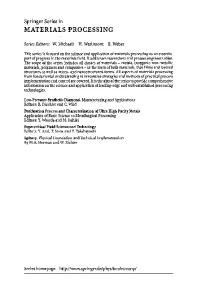Characterizing Polymer Surfaces and Interfaces
- PDF / 521,755 Bytes
- 5 Pages / 576 x 777.6 pts Page_size
- 96 Downloads / 404 Views
LLETIN/JANUARY 1996
depending upon the proximity to the demixing point, can lead to surface effects that propagate many molecular diameters into the sample. The key, however, is the connectivity of the monomers in the polymer chain, which can enhance surface effects, as in the case of block copolymers or polymer mixtures, or suppress surface effects, as in the case of homopolymers. Understanding the behavior of polymer molecules at interfaces requires techniques that can probe the structure and concentration of polymer chains on submolecular size scales. While simulations have provided a wealth of detailed information on the nature of polymer chains at interfaces, we must obtain experimental results to either support or refute the ideas put forth by theory and simulations. Over the past few years, several techniques have emerged that provide such information. X-ray photoelectron spectroscopy (discussed by Gardella in this issue), having a depth resolution on the 0.1-nm scale, provides information on the concentration of polymer chains at a free surface. Ion-beam techniques (discussed by Kramer in this issue), such as forward recoil spectrometry, dynamic secondary ion mass spectroscopy, and nuclear reaction analysis, can penetrate deeply into a sample but have a somewhat lower depth resolution on the 10s to 100s nm size scale. This article discusses the use of radiation, both with x-rays and neutrons, to probe the surface structure of polymers and the concentration of polymers at surfaces and interfaces. While one gains depth resolution of the order of 0.5 nm and maintains deep penetration capabilities, the density profiles are not obtained in real space but rather in Fourier space. This introduces some ambiguity in the
interpretation of the data. However, used in conjunction with other techniques, neutron and x-ray methods offer a unique means of quantitatively investigating the surface and interfacial behavior of polymers.
X-Ray and Neutron Reflectivity X-rays or neutrons incident on a surface at an angle 9 will be reflected at an interface in a manner that can be described by simple Fresnel optics. For xrays or neutrons, the refractive index n can be written simply as4 n = 1 - 5 + i/3
(1)
where 8 is the real and j8 the imaginary part of the refractive index. For x-rays, 8 depends upon the electron density of the polymer whereas for neutrons, 8 depends upon the scattering-length density. For both x-rays and neutrons, ft depends upon the absorption of the radiation. In general, f3 for neutrons is small and can essentially be ignored whereas for x-rays, /3 can be large for high atomic-number elements. For both x-rays and neutrons, 8 is of the order of 10~6. Therefore, n is only slightly less than unity. Consequently, for angles below a critical angle 6 < 6C, the radiation is totally, externally reflected at the surface. For d < dc, an evanescent wave extends beyond the surface, which forms the basis of grazing-incidence scattering methods. For 8 > 0c, the radiation penetrates into the sample and the reflected rad
Data Loading...








